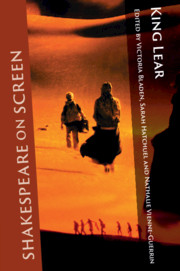Book contents
- Shakespeare on Screen: King Lear
- Series page
- Shakespeare on Screen: King Lear
- Copyright page
- Dedication
- Contents
- Illustrations
- Notes on Contributors
- Series Editors’ Preface
- Acknowledgements
- Chapter 1 Introduction: Dis-locating King Lear on Screen
- Part I Surviving Lear: Revisiting the Canon
- Part II Lear en Abyme: Metatheatre and the Screen
- Part III The Genres of Lear
- Part IV Lear on the Loose: Migrations and Appropriations of Lear
- Chapter 10 Relocating Jewish Culture in The Yiddish King Lear (1934)
- Chapter 11 The Trump Effect: Exceptionalism, Global Capitalism and the War on Women in Early Twenty-first-century Films of King Lear
- Chapter 12 Looking for Lear in The Eye of the Storm
- Chapter 13 Between Political Drama and Soap Opera: Appropriations of King Lear in US Television Series Boss and Empire
- Chapter 14 Afterword: Godard’s King Lear
- Chapter 15 King Lear on Screen: Select Film-bibliography
- Index
- References
Chapter 10 - Relocating Jewish Culture in The Yiddish King Lear (1934)
from Part IV - Lear on the Loose: Migrations and Appropriations of Lear
Published online by Cambridge University Press: 10 September 2019
- Shakespeare on Screen: King Lear
- Series page
- Shakespeare on Screen: King Lear
- Copyright page
- Dedication
- Contents
- Illustrations
- Notes on Contributors
- Series Editors’ Preface
- Acknowledgements
- Chapter 1 Introduction: Dis-locating King Lear on Screen
- Part I Surviving Lear: Revisiting the Canon
- Part II Lear en Abyme: Metatheatre and the Screen
- Part III The Genres of Lear
- Part IV Lear on the Loose: Migrations and Appropriations of Lear
- Chapter 10 Relocating Jewish Culture in The Yiddish King Lear (1934)
- Chapter 11 The Trump Effect: Exceptionalism, Global Capitalism and the War on Women in Early Twenty-first-century Films of King Lear
- Chapter 12 Looking for Lear in The Eye of the Storm
- Chapter 13 Between Political Drama and Soap Opera: Appropriations of King Lear in US Television Series Boss and Empire
- Chapter 14 Afterword: Godard’s King Lear
- Chapter 15 King Lear on Screen: Select Film-bibliography
- Index
- References
Summary
The Yiddish King Lear, directed by Harry Tomashefsky in 1934, is an 80-minute American movie in Yiddish with English subtitles. It is based on a play in Yiddish (Der Yudisher Kenig Lir) by Jacob Gordin, a Russian Jewish playwright and poet, written in 1892. Its cultural significance lies in the play’s reviving Jewish theatre and the film’s contributing to the development of Yiddish cinema. Gordin rewrote Shakespeare’s play most probably in order to put Jewish theatre onto more serious tracks, whereas Tomashefsky revived it as part ‘of the Federal Theatre Project’s Yiddish Unit, created under a plan to put unemployed Yiddish actors back to work at the height of the Great Depression’ (Joel Schechter). The chapter tries to answer a number of questions linked with adaptation strategies concerning both Gordin’s play and Tomashefsky’s film: how does Shakespeare’s text inform the fictional world of the Jewish quarter in Vilna? How are tradition and change reflected in the film? What place does the film occupy in cinema in Yiddish? What status does the film enjoy in adaptation theory? Finally, what kind of Shakespeare derivative does it constitute?
- Type
- Chapter
- Information
- Shakespeare on Screen: King Lear , pp. 157 - 170Publisher: Cambridge University PressPrint publication year: 2019
References
Works Cited
- 1
- Cited by

